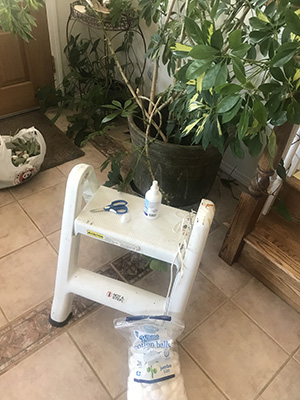November 7, 2020
Managing Mealybugs on Treasured Houseplants

Question:
Can I put peroxide in the soil to kill the mealybugs on our schefflera?
- Tyra T., Los Lunas
Answer:
I don’t recommend it. While hydrogen peroxide is not likely to kill your huge houseplant, it’s not going to kill your mealybugs either.

Full disclosure to readers: I worked with Tyra over the summer, and we’ve been discussing ways to handle these mealybugs since she discovered them on her mom’s 12-foot-tall, 20-year-old dwarf umbrella tree (Schefflera arboricola) in May. At first Tyra reported that leaves were dropping, and she suspected powdery mildew. On closer inspection, we were able to identify the white flecks and cottony clumps as evidence of a dreaded but all-too-common houseplant pest: mealybugs. I warned her that these pests are very difficult to control and may take some serious time, but for a plant this old and big and beautiful, I believed it would be worth the effort.
For a November 2017 column on winterizing houseplants, I invited Dr. Carol Sutherland, NMSU Extension Entomology Specialist and NMDA State Entomologist, to help readers understand what mealybugs are and why they’re so hard to get rid of: “Mealybugs are the bane of existence for indoor plants. Distant relatives of aphids, mealybugs get their common name from the mealy, white, waxy substance that covers the bodies of adults and nymphs. This body covering is exuded from glands in the backs of the insects. The wax protects these pests from water droplets as well as most topical insecticide treatments. Another problem is that mealybugs are mobile and tiny, 2–3 mm long at most for adult stages. They are adept at hiding in natural crevices on the plant as well as on the lower stems and roots below the soil surface. It is nearly impossible to find and kill all of these pests, even with diligent inspection and most non-systemic insecticides. Under these circumstances, surviving mealybugs can continue to feed on plant sap with their piercing-sucking mouthparts and reproduce without significant interruptions.”

Physically removing the visible creepy, cottony crawlers and their cottony egg masses is the best way to go about managing this pest without pesticides or dragging the whole huge plant outside to hose off with a hard stream of water. No matter what method you use, there are bound to be some survivors, so expect to repeat treatments in months and years to come. I recommended carefully wiping around all of the leaves (under, between, etc.) with a damp paper towel and getting into the crevices with a cotton swab soaked in rubbing alcohol. Tyra went to work, and a few days later I got an update via text message: “Slow and tedious process!”
Fast forward five months and Tyra sends another text asking the question for this week’s column about whether hydrogen peroxide applied to the soil will help. We can guess that controlling this infestation continues to be a problem. So I checked in again with Dr. Sutherland who said, partially in jest, that hydrogen peroxide is more likely to clean the eggs than actually kill them. I asked about using a spike form systemic insecticide—really more like a huge pill that goes into the soil—labeled specifically for houseplant use to control mealybugs, with the active ingredient of 2.5% imidacloprid. Dr. Sutherland agreed that this small amount of pesticide will be taken up by the roots, travel through the vascular system of the plant, and be ingested by the tiny mealybugs as they feed on the plant. The majority of the eggs are actually up in the leafy part of the plant, hidden in some of those cottony masses, so manual removal is still going to be needed. In our Zoom video meeting, Dr. Sutherland made the hand gesture of using dental floss to be sure to reach in all the nooks and crannies.
In my own experience, I’ve had decent results using the power combo of cotton swabs and 2.5% imidacloprid insect control tablets. I’ve given up on some smaller plants and just thrown the poor things away. Others seem to do better when I move them outside for the summer—that is, as long as I remember to water them frequently. Keep an eye out for mealybugs when you water your houseplants this winter. Quarantine infected plants immediately. Controlling these annoying pests when populations are low and isolated is your safest bet.

Marisa Y. Thompson, PhD, is the Extension Horticulture Specialist, in the Department of Extension Plant Sciences at the New Mexico State University Los Lunas Agricultural Science Center, email: desertblooms@nmsu.edu, office: 505-865-7340, ext. 113.
Links:
For more gardening information, visit the NMSU Extension Horticulture page at Desert Blooms and the NMSU Horticulture Publications page.
Send gardening questions to Southwest Yard and Garden - Attn: Dr. Marisa Thompson at desertblooms@nmsu.edu, or at the Desert Blooms Facebook page.
Please copy your County Extension Agent and indicate your county of residence when you submit your question!